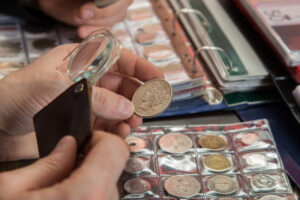 The process of assessing the state of a coin, one of the most critical factors in determining its value, is often termed coin grading. In general, evaluating the quality of a coin involves the following six elements: Strike, preservation, lustre, colour, and eye appeal. At times, the state or nation of issue of the currency is also a factor considered, as well.
The process of assessing the state of a coin, one of the most critical factors in determining its value, is often termed coin grading. In general, evaluating the quality of a coin involves the following six elements: Strike, preservation, lustre, colour, and eye appeal. At times, the state or nation of issue of the currency is also a factor considered, as well.
What are Certification Number and Grading Systems?
A certification number is a unique number that is provided on the label in relation to coins that a third party has graded. This code enables it to have a place in the database of a grading company like True Grade. It also helps establish the authenticity of the coin and checks the accuracy of the grade printed on the insert.
Typically, a nine-digit figure for CACG, that is, Certified Acceptance Corporation Grading, is followed by a number that indicates the coin number from the submission when it is not very clear when viewed from a distance. An L denotes “Legacy” if the coin is being transferred from a prior CAC-approved service holder. The digits before the certification number denote the coin’s grade, period, and sequence number of the coin within the CAC database. The format of PCGS and the format of CACG share many similarities in their layout.
Similarly, COA is referred to as a certification number given by NGC, which constitutes the number of invoices submitted and the order of each coin beginning with a seven-digit number. The digits “3193674” are the identification number for submission or order of the Barber half dollar illustrated above left. At the same time, the -002 indicates that it was the second coin graded from that order.
Depending on the series, a grading Service known as PCGS was founded in February of 1986 and implemented a seven-digit certification number. NRC’s phone numbers were in the seven-digit format up to the middle of the 1990s; since then, it has adopted the eight-digit format. This is typically found at the front surface of the insert, and it is the font of a PCGS certification number, but it is what PCGS uses for the back of some of the novelty inserts. The first digits before the certification number refer to the grade, age, and sequence number of the coin in the PCGS database.
The Value of True Grade
There is very often uncertainty, and collectors work with a need for more information and decide the price of an item based only on their feelings. Worse still, when they are disposing of some costly items such as heirlooms, they may be exploited.
Relative to True grade, the identification, authentication, and grading industry is very intricate, cost-intensive, and involves a lot of unnecessary procedures. Collectors are required to send a product to a centre, pay a high price, and wait for their item back after it has been authenticated, as well as its condition assessed and given a grade. This rating is often anecdotal, and far too usually, something that should have had a higher rating doesn’t.
How to Verify Graded Coins
There are generally five main components that determine a coin’s grade: lustre, coloration, eye appeal, and, by implication, one’s capacity to execute a strike to surface preservation. Coin grade verification is strict, and people can even argue over the grade of that particular coin. Even experts differ in Grading.
Surprisingly, proof coins are graded in the same way as ordinary coins of the series but constantly acquire the abbreviation PR (sometimes PF). Thus, if there is some or a lot of wear on a proof coin, then such a coin will be termed as Impaired Proof, and it will acquire the grade in proportion to the impairment.
How can the grade of a particular coin be ascertained? Some of the recognized grading service providers across the world are the Numismatic Guaranty Corporation (NGC). Their online grading databases are pretty exhaustive, which provides the ability to cross-check the grades on the holders by the ID numbers.
How does one obtain coins that have been officially graded?
The basic process is that you:
- A Pay to join type of submission club.
- Please provide all the necessary papers that would help identify the coin and its insurance value.
- Treat the coins as per the standing of the grading company when packing them.
- There should be an option through check or a credit card to Pay for the Coin Grade Verification.
- When you want to send the coins to the grading company, the coins are assigned a rating of 1 to 70; 1 is considered to be the lowest quality, while 70 is perfect mint circulated. The naming conventions also pose a problem because, for example, a “Good” score is a 4/70 while “Fine” is a 12.
While all this is possible, it will take one to five years of experience to decide whether a particular coin is suitable to be graded by oneself or not. Traders, for instance, may feel that the coins they are selling are cleaner than they really are– so you need to be vigilant.


